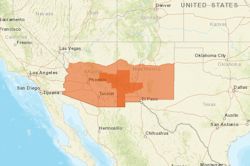SEJournal Online is the digital news magazine of the Society of Environmental Journalists. Learn more about SEJournal Online, including submission, subscription and advertising information.
 |
| The jaguar, endangered in Mexico and nearly gone in the United States, is one of a number of wild species whose migration may be harmed by the contested border wall. Others include gray wolves, pronghorn, coyotes, owls, butterflies and certain plant species. Photo: U.S. Fish and Wildlife Service/Ron Singer. Click to enlarge. |
TipSheet: Border Wall a Way into Environmental Stories
You can safely infer from the fact that three environmental groups so far have gone to court to stop President Donald Trump’s contested border policy, that the wall is actually an environmental story.
And it’s one with not just local environmental implications, but impacts that reach well beyond the immediate border area.
Here’s some background, along with possible story handles and resources.
Back story
Having lost his bid for border wall money in the Congressional budget deal (may require subscription), Trump declared a state of emergency (may require subscription) that he hopes will allow him to reprogram other appropriated money to spend on wall construction. A lot of lawsuits followed.
Some of those suing, significantly, were environmental groups. The Center for Biological Diversity, Defenders of Wildlife and Animal Legal Defense Fund were the three in the lead.
They filed their complaint Feb. 16, calling Trump’s proclamation “unlawful on its face.” As it goes up the ladder of appeals, the case could be consolidated with the many others challenging not simply the wall, but the legality of the emergency declaration and of the reprogramming of funds.
It is worth remembering that this is not the first time environmentalists have challenged Trump in court over the wall. There were at least three earlier suits during the Trump tenure.
A key point of litigation was the legality of waivers of environmental laws which the Trump Department of Homeland Security gave itself to build previously planned wall segments. With this objection, they had gone all the way to the Supreme Court — which rejected their case in December 2018.
Why it matters
There are a number of reasons why a wall would be environmentally important … and harmful.
 |
| A map showing the U.S.-Mexico border region with populations of the Mexican Gray Wolf, portions of which are endangered and may be further affected by new border barriers. Map: U.S. Fish and Wildlife Service. Click to enlarge. |
One most often cited is that many wild species (may require subscription) cross the border as they range or migrate, so that blocking those movements would harm the species and contract its range.
Another is that the border corridor itself constitutes significant wildlife habitat, which would be destroyed, damaged or reduced by wall construction activities. For example, it would be common practice to bulldoze a strip of land beside the wall.
One oft-covered example is the National Butterfly Center, a nature center on 100 acres of private land that straddles the border, right on the Rio Grande near Mission, Tex. The center sued to stop Trump (may require subscription) from building his wall right through their land.
Before the case could really be decided, Congress added language protecting the sanctuary into the shutdown-averting budget deal. But if Trump finds wall money outside that bill, as he wants to do via the emergency, then the protections would not apply.
The most charismatic example of megafauna that crosses the border may be the jaguar, a species endangered in Mexico and almost obliterated from the United States. But you could also look at the (endangered) Mexican gray wolf, ocelots or the Sonoran pronghorn.
Of course, not all the affected species are mega- or charismatic. Examples: the coyote, the ferruginous pygmy-owl, the Quino checkerspot butterfly, the Mexican flannel bush or the Tecate cypress.
Story ideas
Here are some possible story handles.
- Pick a species of interest or concern to your community, and look into the story of how it might be affected by the border wall.
- What are the implications of the border wall for the National Parks and Wildlife Refuges along the border?
- What military construction projects (elsewhere in the country) would lose money under the Trump emergency? Do any of them affect your area or the military families within it? Some examples are here, here and here.
- Examine one of the many communities along the border that would be affected by the wall. There are many hundreds of colonias along the border, often unincorporated (may require subscription) and typically poor communities with limited infrastructure and environmental services.
- Examine one of the many border tribes that might be along the wall’s route. One that has gotten lots of media attention is the Tohono O’odham Nation in Central Arizona and Northern Mexico. But there are others, such as the Carrizo Comecrudo tribe of South Texas.
Reporting resources
- U.S. Customs and Border Protection. This is the federal agency that controls the borders. The Border Patrol is a police agency within CBP.
- Center for Biological Diversity, Defenders of Wildlife and Animal Legal Defense Fund. These are the animal advocacy groups suing the Trump administration over the border wall.
- Region 6, U.S. Environmental Protection Agency. EPA has a program called Border 2020, which addresses a range of border environmental issues. Contacts here.
- International Boundary and Water Commission. This is the binational forum for dealing with a set of U.S.-Mexico water treaties. The issues are very technical, complex and political.
- Southwest Environmental Center. This nonprofit advocacy group addresses many border wall issues.
* From the weekly news magazine SEJournal Online, Vol. 4, No. 9. Content from each new issue of SEJournal Online is available to the public via the SEJournal Online main page. Subscribe to the e-newsletter here. And see past issues of the SEJournal archived here.














 Advertisement
Advertisement 



